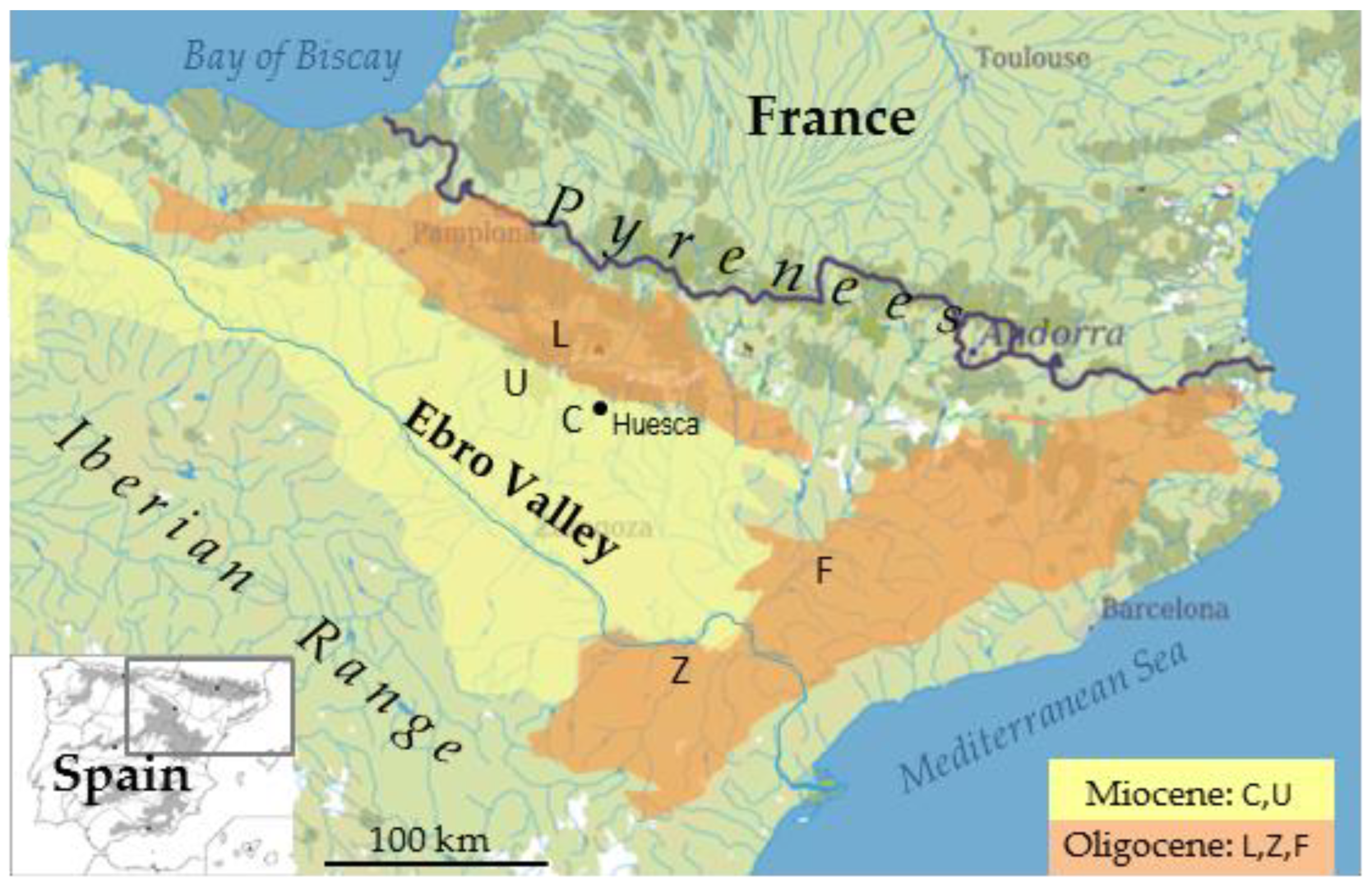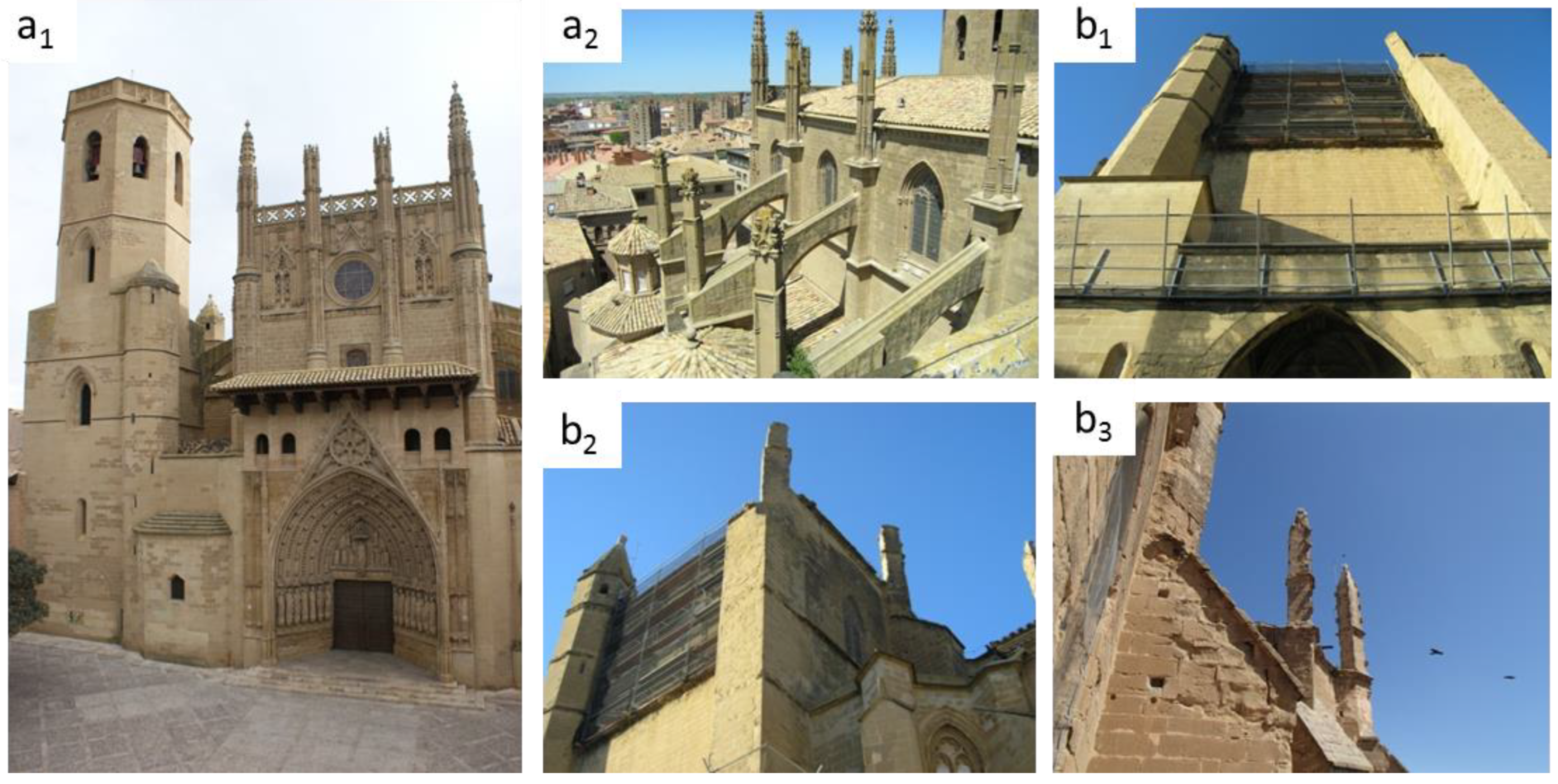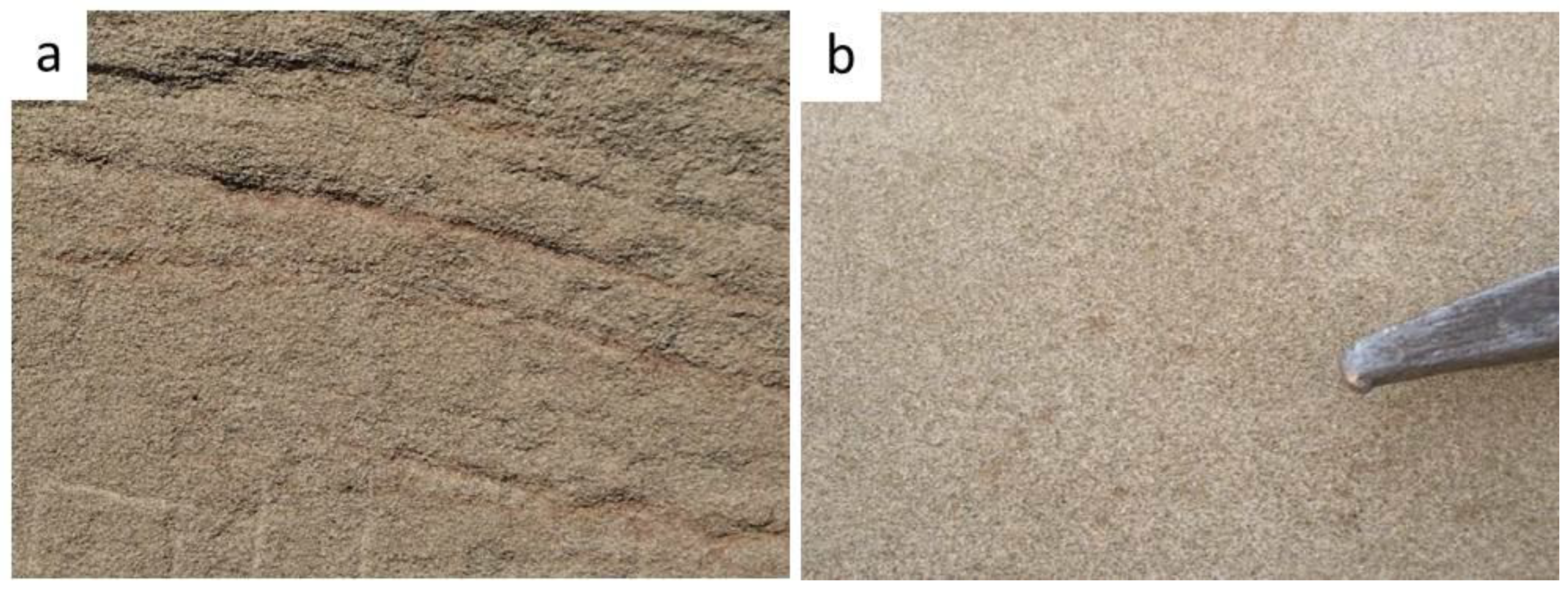In order to manage problems arising from rainwater/rock interaction in Miocene sandstones (calcareous litharenites) widely used in various monuments of the Ebro Valley (NE of Spain), a survey has been conducted with particular application to the building and architectural decorative materials of the Cathedral of Huesca.
1. Ebro Valley Natural Stone: Miocene Sandstone in the Cathedral of Huesca
Tertiary terrigenous deposits, consisting mainly of sandstones and lutites of Pyrenean fluvial origin, dominate a large sector of the northern Ebro Valley, NE of Spain (
Figure 1). Miocene sandstone, part of the so-called Sariñena Formation, was the natural stone most widely used for building purposes, especially during the mediaeval period. Abbeys, castles, defensive walls, and churches of different size, from small chapels to huge temples, were erected using this local material. The city of Huesca, administrative capital of this Aragonese sector, with a rich historical past, was not an exception. The main stone used for construction of its most emblematic monuments is the local sandstone that emerged by filling paleochannels of metric-decametric lateral extension and variable thickness up to 5–7 m, but also crops out in almost horizontal tabular beds of lower thickness but greater lateral continuity. Within a radius of less than 15 km around the city, at least 12 sectors of historic quarries have been recognized where the stone was extracted in a more or less systematic way. In all of them, sandstone was removed in a distributed way, either dismantling blocks exposed by erosion, or from the top of monadnocks, or by staggered exploitation of escarpment fronts
[1].
Figure 1. Geological sketch and location of the evaluated sandstones in the Ebro Valley, NE of Spain. C (Cathedral of Huesca); U (Uncastillo, Zaragoza province); L (Alastuey, Huesca province); Z (Alcañiz, Teruel province); F (Floresta, Lérida province).
The Gothic Cathedral of Huesca, erected with this sandstone between the end of the 13th century and the beginning of the 16th century, was emplaced in a strategic location on the top of a hill dominating the entire city. This location, away from natural soil moisture sources, has helped to maintain its integrity, unlike the damage observed in other monuments where continuous contact with groundwater has caused irreparable decay to their stone baseboards related to crystallization of salts
[2]. However, in the framework of the pre-restoration project commissioned by the Department of Culture and Heritage of the Aragonese Government to the University of Zaragoza, different forms of damage were recognized in the upper half of the southern façade and transept of Huesca Cathedral (
Figure 2).
Figure 2. Different views of the outside of Huesca Cathedral. (a) Previously restored areas; (a1): Main Façade (Courtesy of the Huesca Diocesan Museum); (a2): Part of the southern stonework. (b) Various aspects of the southern façade under study; (b1): View of the protective fence; (b2): Upper-half of the façade with a scaffolding; (b3): Partial view of the stone decay.
2. Stone Decay in the Cathedral of Huesca
The main façade (Figure 2(a1)) and part of the southern stonework (Figure 2(a2)) were the subject of different restorative interventions during the last century. The rest of the stone masonry has been partially treated over the years but it has recently been necessary to place a protective fence to collect the stone fragments that often fall from the pinnacles (Figure 2(b1)). The deterioration affects the integrity of the sandstone to varying degrees, depending on its location and function in the building. After visual inspection of the upper-half of the southern external façade (Figure 2(b2)), three different types of damage were recognized: loss of material in the dimensioned ashlars and decorative stone pieces, as well in the joint mortars; presence of fissures and cracks; and extensive biodeterioration with development of biofilms and the effects of birds nesting (Figure 2(b3)). Their intensity and development are increased by the combination of them.
From the observed damage and its location in the building, it was possible to determine the main causes of the decay, following well-known established criteria
[3][4][5][6][7][8]. They were categorized into two types: those associated to intrinsic factors, or inherent to the proper material; and those external or mainly related to the environment and with the implementation of the stone. In terms of natural defects, laminations (
Figure 3a), whether of different particle size or of various components (such as clays scattered throughout the matrix or in nodules of soft material), are potentially very vulnerable elements to weathering
[9]. These accumulations of argillaceous matrix, in a subrounded or elongated form, sometimes of centimetric size, scattered throughout the whole, offer a characteristic “mottled” appearance (
Figure 3b). Concerning the external factors, this sandstone is affected by the strong seasonal contrast of the Mediterranean-semiarid climate of the area
[6][10]. The joint action of all factors, along with the lack of regular maintenance work, maximizes the observed detrimental decay. Different physical, chemical, and biological weathering processes are involved, among which those directly associated with rainwater interaction with this porous material are potentially the major contributor to aesthetic changes and even direct loss of material
[9][11][12][13].
Figure 3. Natural defects in the sandstones used in the Cathedral of Huesca. (a) Presence of argillaceous laminations. (b) Scattered aggregates of clay matrix.
Among the zones identified with serious deterioration, the gutter of the roof was weathered by the effects of long-term rainwater/rock interaction. In general, the causes are associated with the presence and retention of water in any of its states, involving several hydric processes added to the combined effects caused by the implantation of microorganisms. Thus, the direct infiltration of rainwater through discontinuities and absorbed by the porosity of the stone produces significant damage to the pieces that make up the roof ledge, constituting the starting point of the progressive deterioration. In the lower part of this gutter, which also forms a decorative cornice, the accumulated humidity enhances the vulnerability of the rock with total loss of material, even its stony decoration (Figure 4a).
Figure 4. Different views of the deteriorated stonework in the Cathedral of Huesca. (a1,a2): Loss of material in the cornice and decorative balls below the gutter; (b1,b2): External corridor (ándito): weathering on the surface and the first raw ashlars related to rainwater stagnation and capillary absorption; (c1,c2): Loss of material in the rounded pieces of the glass window (oculus) of the transept.
The negative effects caused by the implantation of microorganisms help to retain the moisture, and potentially cause both physical and chemical damage
[14][15][16]. Black and greenish-yellowish biofilms are visible in specific areas of the stone masonry and in the decorative cornices. The black films are associated with continuous wetting by direct contact with rainwater collected and channeled on the roof, then poured directly on the stone masonry of the building. Their dark stains mark the areas where moisture is maintained from the fall and infiltration of rainwater from the roof due to its deficient evacuation. Although apparently they do not seem to degrade the stone significantly, they do affect it aesthetically by contrast of colour, compared to the uniformity of the sandstone. However, any area with moisture may evolve into more aggressive forms of alteration
[11][13]. Thus, immediate intervention is required to avoid its further development
[17].
The greenish-yellowish biofilms constitute deposits attached to the stone that support the opening of fissures and loss of joint mortar. They cause slight to moderate damage in the state of the ashlars, but serious problems in the lower part of the cornices. In these biofilms, different microorganisms, such as bacteria, fungi and lichens, enhance decay by increasing the duration of surface wetting and providing a source of organic acids and complexing agents
[4][15][18]. Growth of fungi, which propagate in humid and warm environments but survive even in dry environments, facilitates the retention and increase of humidity, producing pigmentation and acid attacks. Lichens, common to rugged substrates, slowly develop deposits and coloured patina that, in addition to the aesthetic effect, generate patina by silicate solubilization in the stone and calcium leaching in the mortars
[15][19][20][21]. Their massive growth causes serious deterioration in the stone over a wide range of temperature and humidity, with active resistance to drought. They excrete organic acids and reabsorb water with expansion and contraction cycles, thus increasing the porosity of the rock from which they capture water, a process that can cause greater damage by frost weathering during the winter. Mechanical pressure due to the shrinking and swelling of the colloidal biofilms might cause further weakening.
Moisture retention in the pore and fissure network accentuates the degradation process depending on the ambient temperature
[14][19]. Thus, the cyclical changes of humidity-dryness associated with rainy days, but also with fog, are enhanced by strong insolation at certain times of the year, especially in the southern-facing stone masonry. The combined effect of progressive disintegration, both physical and chemical, implies a significant loss of material, with reduction of the section and even total loss of stone material
[11][12].
This problematic effect is especially visible in the inferior part of the cornices where significant loss of material, including the decorative elements, forces their complete replacement (Figure 4a). Additionally, the stagnation of rainwater on the surface of the gallery (ándito) causes physical damage in the first rows of wall ashlars just above this surface by capillary suction (Figure 4b). In other areas, the direct gravitational fall of rainwater collected from the roof on some pieces, such as those that make up the round glass window of the transept (oculus), has resulted in the loss of material in the pieces most exposed to this contact, which also need to be replaced (Figure 4c).




